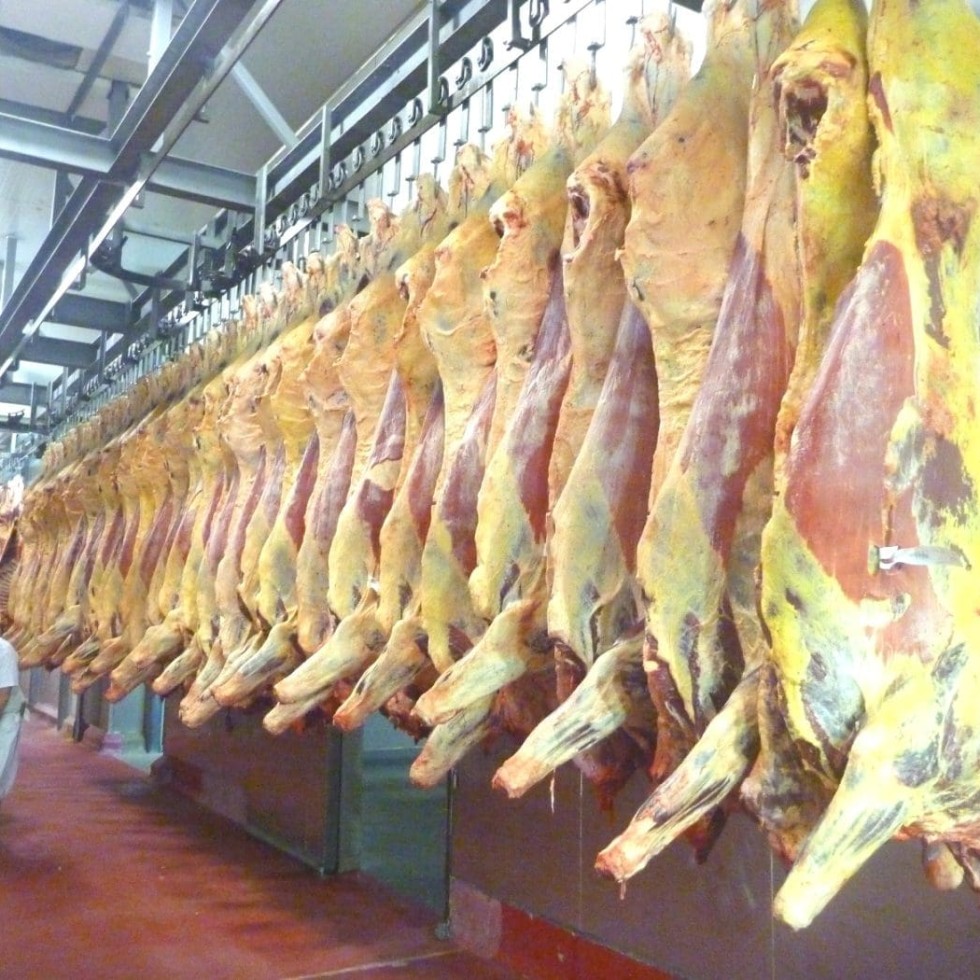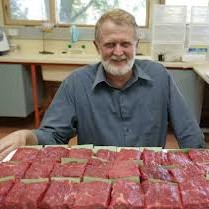 A small, but vocal group of stakeholders, ranging from producers to meat scientists, support the view that it’s time to re-examine the industry’s AusMeat language and industry carcase assessment systems in general.
A small, but vocal group of stakeholders, ranging from producers to meat scientists, support the view that it’s time to re-examine the industry’s AusMeat language and industry carcase assessment systems in general.
And the general opinion that’s being formed is that that process should not be confined to specific ‘problem areas’ like butt shape, but should examine the entire spectrum of carcase yield and quality indicators used across kill-floor, chiller assessment and MSA grading.
The apparent inconsistencies exposed in the application of the butt shape carcase measurement, resulting in championship-standard 100-day grainfed competition entries being heavily discounted on price (click here to view Beef Central’s earlier story), could become a broader catalyst for change, they believe.
One of the people supporting such a move is Central Queensland beef producer Ian McCamley, who has been a vocal opponent to the contradictions evident in the industry’s parallel carcase assessment systems applied under the AusMeat language, and more recently introduced MSA grading.
His particular grievance is over the inconsistencies evident between the use of AusMeat dentition (as an indicator of age/maturity, and hence likely quality/tenderness), and ossification, used for the same purpose under the parallel MSA system.
There have been numerous episodes where cattle have failed to grade on the basis of their dentition score, only to perform well within acceptable eating score boundaries under MSA, based on their ossification and overall meat quality scores. That costs their owners big discounts.
 “In my view, it’s time to put a process in place to scrutinise Australia’s entire carcase appraisal/sorting methodology,” Mr McCamley said.
“In my view, it’s time to put a process in place to scrutinise Australia’s entire carcase appraisal/sorting methodology,” Mr McCamley said.
But rather than simply reviewing the existing appraisal/sorting tools like butt shape and dentition one-by-one, he suggests it may be better to start with a ‘blank sheet of paper’ approach.
“That means ignoring what we currently use, and simply consider what the modern Australian beef industry needs to achieve in carcase assessment and sorting tools, and then go out and determine the best ways to deliver it,” he said.
“It’s crazy that we are still using descriptors like butt profile that have been widely dismissed for years as irrelevant, by respected meat scientists like John Thompson and others.”
Mr McCamley said there had to be concerns where brand new export markets were being opened up for Australian beef, when antiquated and in some cases, scientifically-disproved AusMeat yield and quality assessment tools were being suggested and applied.
“They’ll say country X wants to buy Australian product, using this (AusMeat) language. But when you cross-examine them, you find that that was the only option provided to the customer in the first place. They have no particular interest in butt shape, or dentition as specific quality attributes – all they want is an assurance that the product they receive will eat to their expectations,” Mr McCamley said.
“Producers, ultimately, are the losers when that happens.”
Western Downs beef producer Lee McNicholl, who led the outcry over butt shape results and discounts seen in Brisbane Show’s recent grainfed competition, agrees with the need for a comprehensive review of the current assessment model.
“It is patently obvious that a thorough, objective meat science based review of AusMeat’s highly subjective beef carcase grading language is long overdue,” he said.
“Hard-pressed beef producers have had a gut-full of processors using AusMeat’s flawed, inaccurate system as a de facto ‘Weapon of Mass Discounting’ to unjustly discount their cattle,” Mr McNicholl said.
So who is ultimately responsible for the content in the AusMeat language?
The buck stops not with the AusMeat Ltd body itself (a joint venture under the control of a board appointed by MLA and AMPC, which is simply a service delivery provider along the same lines as MLA), but with the Australian Meat Industry Language and Standards Committee (AMILSC).
According to AusMeat literature, AMILSC provides advice to the AusMeat Ltd board on matters relating to the AusMeat National Accreditation Standards.
The AMILSC committee is made up of industry sectoral representatives. Membership includes:
- Australian Meat Industry Council
- Cattle Council of Australia
- Australian Lot Feeders Association
- Sheepmeat Council of Australia
- Australia Supermarkets Institute
- Australia Pork Ltd (the Ausmeat language also covers pork), and the
- Meat Standards Committee.
Significantly, AusMeat’s own literature says the committee “provides the forum for converting industry policy into practical, workable industry-owned national standards.”
Beef Central asked Cattle Council of Australia, which holds a seat on AMILSC, where it stood on the butt profile issue.
“CCA does not have a policy on Butt Profile specifically,” Beef Central was told.
“There are a number of criteria placed on grids by various processors. As we invest more producer levies in MSA R&D, we are starting to learn that many of the traditional measurements are not as accurate or appropriate at determining carcass value as we once thought,” CCA said.
“As we develop new science and a greater understanding of what the consumer desires from their beef, it is becoming apparent that it may be time to review our measurements and make sure that there is a legitimate, science-based approach to them.”
AusMeat chief executive Ian King provided some background information on the language, at Beef Central’s request.
The document said the AusMeat Language was a “common language which uses objective descriptions to describe meat products accurately to meet market requirements both nationally and internationally.”
“The Language is the basis of a national uniform description system based on objective carcase measurements used in the classification of Australian meat and livestock” the document said.
The Language includes the beef carcase evaluation (Chiller Assessment Program) and has been integrated within the Meat Standards Australia (MSA) grading system, where common measurements / assessments are used.
Mr King said over the years, and as recently as several years ago, the ‘industry’ (via the Australian meat industry language and standards committee) had undertaken reviews of the inclusion of butt shape within the Language.
“The industry decision to retain butt shape in the Language allows AusMeat to audit those (companies) that use the measurement, thus ensuring consistency of application. Therefore butt shape remains an optional slaughter floor carcase measurement,” Mr King said.
A well-informed producer who asked to remain anonymous said whilst the members of the AMILSC committee were the only people who could provide a solution to current perceived flaws, they remained ‘firmly devoted’ to the current model, in his opinion.
“The AMILSC has had the science at their fingertips for years, yet they remain completely unwilling to change some of the ridiculous unscientific AusMeat measurements. It is becoming very clear that the stronger members on this committee (Beef Central interpreted that to mean processors) must sadly (for producers) believe that their own supply chains will be at risk if changes are made.”
While it is hard to find any industry stakeholders prepared to publicly defend butt shape, one large processor close to the AusMeat language process told Beef Central that while butt shape remained a crude (at best) indicator of carcase yield, it persisted in the language only because of the absence of anything better.
He conceded that the highly subjective nature of the assessment flew in the face of AusMeat’s claims, outlined above, that the language is based on ‘objective carcase measurements.’
Other criteria need close examination
In discussions with a range of respected industry stakeholders from across the supply chain about the butt profile issue this week, Beef Central has identified a number of other carcase assessment criteria that may be worthy of closer scrutiny under any industry review that should emerge.
Fat distribution:
Carcases are sometimes (perhaps infrequently) discounted on the basis of distribution of fat – not to be confused with outright fat depth. The justification for grid penalties has always been the potential impact on carcase value from ‘chiller burn’ caused by lack of protective fat cover over the hindquarter.
“Fat distribution, as a pricing tool, is something that needs review,” a leading processor said.
“Back in the 1990s, a lot of meat, especially in butcher shops, hung in chillers for days, meaning bare butts risked chiller burn. But today beef goes through the boning room and into a Cryovac bag within 20 hours of slaughter. Chiller burn is no longer an issue, especially with modern chiller designs, and the advent of spray chilling. And in the domestic market, butchers no longer buy body beef – everything is in cartons.”
P8 fat depth:
Former Beef CRC meat scientist Professor John Thompson said while butt shape was an obvious candidate for removal from the AusMeat language on the basis of its irrelevance as a yield indicator, the accuracy of the P8 location for fat depth measurement, over the alternate 12/13 rib location used overseas, was another area worthy of scrutiny.
 “P8 was brought-in in Australia, because it was not supposed to have the same ‘fat tearing’ problems that 12/13 rib does,” he said.
“P8 was brought-in in Australia, because it was not supposed to have the same ‘fat tearing’ problems that 12/13 rib does,” he said.
Fat tearing, when the hide is mechanically-removed and pieces of fat under the skin surface peel away with it, can have a very large impact on grid pricing, based on minimum fat depth requirements set by processors. Some say the fat-tearing issue becomes greater the faster the chain speed in the plant: the bigger the plant, the faster the hide must be removed.
“But there’s abundant evidence that there’s just as much fat tearing going on over the P8 site as there is over the 12/13 rib site,” Prof Thompson said.
Different quartering sites for fat depth assessment are used in Japan (marbling motivated), North America and Europe.
Dentition versus ossification:
Prof Thompson agreed with Ian McCamley’s assessment that dentition also needs to come under closer scrutiny as a carcase sorting tool.
“Our CRC research shows that once we have graded a carcase using MSA criteria (including ossification), the further addition of dentition adds absolutely nothing to the quality prediction,” he said.
“And that applies to a whole range of cuts, from high to low connective tissue, and different cooking style applications. There is an argument that if dentition was better related to connective tissue cross-linking, then it should not be important in slow-cooking methods, but much more important in grilling cuts – but there’s no sign of that in research trials,” Prof Thompson said.
“Ossification, in conjunction with the MSA grading scheme, provides the best estimate of quality. Dentition adds absolutely nothing to the predictability, based on 7000 carcases in our last analysis.”
Prof Thompson agreed with the view that there was little point in launching a scientific review of the butt shape assessment in isolation from other traits.
“It would make little sense to just go in and clean-up the butt shape issue: far better to apply a broader scrutiny across the indicators used by the industry, and clean-out the lot, if need be,” he said.
Are there solutions already out there?
While technologies are already in existence that have yield predictive ability – VIAscan cameras are a good example – it is not as simple as just adopting such systems in place of butt profile.
“VIAscan cameras are not necessarily any better. They never produced any 75pc yield cattle in their assessments, yet such cattle do exist. VIAscan tends to average everything out in the middle ranges,” a large domestic processor said.
“The push for a truly objective form of carcase yield assessment is still valid, it’s just that the industry has run into some dead-ends. VIAscan was a good concept, but it never quite got there. The calculations and predictions weren’t accurate enough, across a broad band of cattle types and degrees of finish,” he said.
Where some exciting new opportunities on yield assessment might lie is in some preliminary working being done by MLA’s Dr Alex Ball, Prof John Thompson and others looking at harnessing the ‘incredible computing power’ of off-the-shelf PlayStation-type gaming consoles to develop a carcase yield assessment tool with real accuracy, reliability and the ability to handle high meatworks chain speeds.
While it was still in its infancy, such technologies might emerge which could have the potential to replace the subjective grader assessment of butt shape, Prof Thompson said. The observations were based on computer-driven assessment of muscling, using thousands of images of carcases captured from different angles, with much greater and more accurate predictive capacity than a conventional butt profile assessment.
Commercial realities
One of the challenges with any review of industry quality and yield assessment indicators is the need to maintain commercial relevance, in the modern world of extremely large, high-throughput abattoirs.
Processors say there would be a host of problems associated with simply replacing dentition with ossification as a maturity assessment, for example.
One of the biggest challenges is that there are currently two competing grading/assessment systems operating simultaneously in many plants, and often with contradictory measurements. The AusMeat grading system operates on the killfloor and chiller (including amongst other measurements, dentition for age, and butt shape for yield), while MSA grading includes ossification for age/maturity, and EMA/fat depth for yield.
While for some, the simple answer might be to simply dispose of dentition and replace it with ossification, while replacing butt shape with EMA, commercial reality suggests it’s not that easy.
A large kill chain in an export abattoir can operate at 200+ bodies per hour. The typical rate of MSA assessment rate is around 46 bodies per hour. That would require another three or four MSA graders, and potential another bank of three or four chillers, just to keep up with the grading requirement if MSA was to be universally adopted.
“The list of ‘why not trys?’ can be as long as your arm,” a major processor contact told Beef Central.
“Why not pay on the yield of meat cut from every carcase? It sounds great, but in reality it is impossible to deliver in any high volume environment. In a practical sense, there are commercial reasons for and against each of those assessments, and why they are currently used.”
“Does a producer in a drought-affected corner of western Queensland who sees half his cattle score meat colours of 4 and high oss want full MSA chiller assessment applied to his cattle? Unlikely.”
The current grading system is far from perfect, but there are perfectly legitimate arguments for and against the current criteria in the system.”
“As a processor, we’re not averse to change, but whatever options are proposed have to take into consideration that we need to make assessments at 200 bodies an hour.”
“Even if we went to full chiller assessment on every carcase, and payment based on boning room yield, there would be producers who would suffer financially, because just as many would be under the average as over it, and would receive less than what they currently do for their cattle.”
Additional submitted reader comments (not submitted via the 'click here to comment' link, see more comments below)
Chris Smith
RE BUTT SCORE ARTICLES. It is interesting that that VIAscan is considered an averaging tool for yield… a statement from a domestic processor… Who is this anonymous person, do they have any creditability for such a statement? From my knowledge there has been only 2 companies in the Aust Beef industry to have installed the Whole carcase Beef VIAscan into plants in the last decade… and in both cases systems were able to predict yield with superior accuracy to that of HCW/P8 on a range of cattle (Domestic, 100day, Japox) based on boning trials done within plant. So why aren't these systems still operating today…1 st plant industry dispute leading to plant closure, and 2nd plant: a merger change of management, change of focus …viascan is pulled out …3yrs of development down the tubes. Was it a failure of the VIAscan to deliver on accuracy and integrationautomation… I don't believe so. Yield/Value based trading can be achieve but requires commitment from both processors and producers. Such as the NZ story: VIAscans is operating in NZ 13 – 14 plants covering lamb and beef. They are currently trading on yield premiums for lamb, it hasn't happen over night but requires commitment from the supply chain industry to do it.
Chris Smith
I think the comment by the “processor” that the Beef VIAscan is not sufficiently accurate needs further justification as it is a convenient slogan to discredit the technology without fully understand what it has achieved. Recent boning trial work that was conduct within Australian demonstrated that the Whole carcase VIascan was superior to HCW +P8FD when estimate the saleable meat yield.
For example for 100 day Bos taurus cattle – HSCW 290–550kg Av 380kg; P8FD: 6–35mm, Av 17.5 mm; SMY% 59.5–74.1%, Av 65.9 – Standard deviation: 2.54%
- HCW +P8FD could describe 20% of the variance in SMY
- Whole carcase VIAscan could describe 53% of the variance in SMY
- Chiller assessment unit alone described 54% of the variance in SMY
- Add the two technologies 70% of the variance is explained in SMY
So compared to what’s available industry at the moment, the VIAscan could provide a pretty good level of accuracy to describe SMY for these type of cattle. It is unfortunate that these results never see the light of day so they can be evaluated/scrutinised by the wider industry.
Keep up the good work fellas, Cheers
Chris Smith
